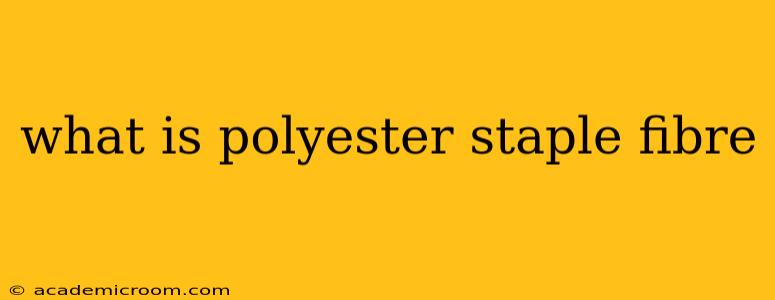Polyester staple fiber is a fundamental building block in the textile industry, used to create a vast array of fabrics known for their durability, wrinkle resistance, and affordability. Understanding what it is, how it's made, and its various applications is key to appreciating its widespread use in everything from clothing to industrial products. This comprehensive guide will explore polyester staple fiber in detail, answering common questions and providing insightful information.
What is the Difference Between Staple Fiber and Filament Fiber?
Before delving into polyester staple fiber specifically, it's crucial to understand the difference between staple and filament fibers. Staple fibers are short, typically ranging from 1 to 5 inches in length, resembling cotton fibers. They're spun together to create yarn, providing the fabric with softness and texture. In contrast, filament fibers are long, continuous strands that are directly used to create fabrics like silk or nylon. Polyester can be produced as both staple and filament fiber, but this article focuses on the staple variety.
How is Polyester Staple Fiber Made?
Polyester staple fiber production involves a complex process of polymerization, extrusion, and cutting. The process begins with the synthesis of polyester polymers, usually polyethylene terephthalate (PET), from raw materials like ethylene glycol and terephthalic acid. This molten polymer is then extruded through spinnerets—small nozzles with tiny holes—forming continuous filaments. These filaments are then cut into short lengths, creating the staple fibers. The length and thickness of these fibers can be precisely controlled during the process, allowing manufacturers to produce a wide range of fiber types with diverse properties.
What are the Properties of Polyester Staple Fiber?
Polyester staple fiber boasts several desirable characteristics that contribute to its popularity:
- Strength and Durability: It's exceptionally strong and resistant to abrasion, making garments and products durable and long-lasting.
- Wrinkle Resistance: Polyester fabrics are renowned for their wrinkle-resistant properties, requiring minimal ironing.
- Water Resistance: It possesses excellent water-repellent qualities, making it suitable for outdoor clothing and other applications where water resistance is crucial.
- Easy Care: It's easy to clean and maintain, requiring less frequent washing and often air-drying quickly.
- Versatile: It can be blended with other fibers to enhance their properties, creating fabrics with a wide range of textures and characteristics.
- Affordable: The relatively low cost of production makes polyester staple fiber a cost-effective option for a wide variety of applications.
What are the Different Types of Polyester Staple Fiber?
Polyester staple fiber isn't monolithic; manufacturers produce variations to meet specific requirements:
- Hollow Polyester Fiber: Offers enhanced insulation properties due to its hollow core, frequently used in winter clothing and bedding.
- Conjugate Fiber: Combines two or more different polymers in a single fiber, allowing for customization of properties like softness or elasticity.
- Modified Polyester Fiber: Through chemical modifications, producers can create fibers with enhanced properties like improved dyeing capabilities or flame retardancy.
What are the Applications of Polyester Staple Fiber?
The versatility of polyester staple fiber makes it a ubiquitous material, found in:
- Clothing: A vast range of garments, from shirts and pants to sportswear and outerwear, utilize polyester staple fiber for its durability and ease of care.
- Home Furnishings: Upholstery, curtains, and blankets frequently incorporate polyester staple fiber for its resilience and wrinkle resistance.
- Industrial Applications: It is used in technical textiles for applications like filtration, geotextiles, and protective clothing.
Is Polyester Staple Fiber Eco-Friendly?
The environmental impact of polyester staple fiber is a complex issue. While its durability and longevity reduce the need for frequent replacements, the production process relies on petroleum-based resources and generates waste. However, there are ongoing efforts to develop more sustainable production methods and increase the recycling of polyester materials, making the future of this material increasingly greener.
What are the Advantages and Disadvantages of Polyester Staple Fiber?
Advantages: Durability, wrinkle resistance, water resistance, easy care, affordability, versatility.
Disadvantages: Can retain moisture (leading to discomfort in hot weather), not as breathable as natural fibers, environmental concerns related to production and disposal.
Is Polyester Staple Fiber a Good Choice for Clothing?
Polyester staple fiber is an excellent choice for clothing when durability, easy care, and wrinkle resistance are priorities. However, for situations demanding breathability and moisture-wicking properties, blends with natural fibers or other specialized polyester variants are preferable. The best choice depends on the intended use and personal preferences.
This detailed exploration of polyester staple fiber aims to provide a comprehensive understanding of this significant material and its impact on various industries. Remember that continuous innovation in fiber technology leads to refinements and advancements, improving the properties and sustainability of this versatile material.
